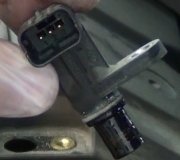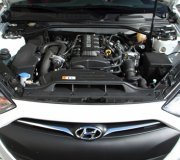Don't try a larger bolt. That might work on other things, but there won't be any way to know the right torque. The bolts could be too tight just from self-tapping into a hole that's too small. That will result in not enough clamping force. Also, a larger diameter bolt will likely require drilling the holes in the cap larger which will weaken it.
The better alternative is a Heli-Coil insert, especially for repairing holes in aluminum. Every auto parts store will have the kits and extra inserts. Take one of the bolts in to have it matched to the right kit. They can show you how to use them too. Most importantly, when the holes are drilled, and when they're tapped, be sure to get all the chips out. A vacuum cleaner might work, otherwise try a stick or cotton swab with a little grease on the end. Don't let the chips fall into the oil either.
When you run the insert in, be sure it's in far enough so no part of it is sticking up beyond the mating surface of the stand. If any is sticking up, it will hold the cap up and prevent it from becoming fully-seated. The tab used to wind the insert in will break off when you run the bolt in. Install the bolt first, then remove it and get that tab out before installing the cap. If you don't remove that tab or drilling chips, the bolt could bottom out against them and give the illusion of being torqued when they really aren't clamping the cap yet.
You can also run the bolt in without the cap in place, and count the number of turns it takes to get snug, then count the turns it takes to get snug with the cap in place. If you can reach the desired torque well before you reach the maximum number of turns, you'll be assured the bolt isn't bottomed out on any chips.
Saturday, January 10th, 2015 AT 12:26 PM


